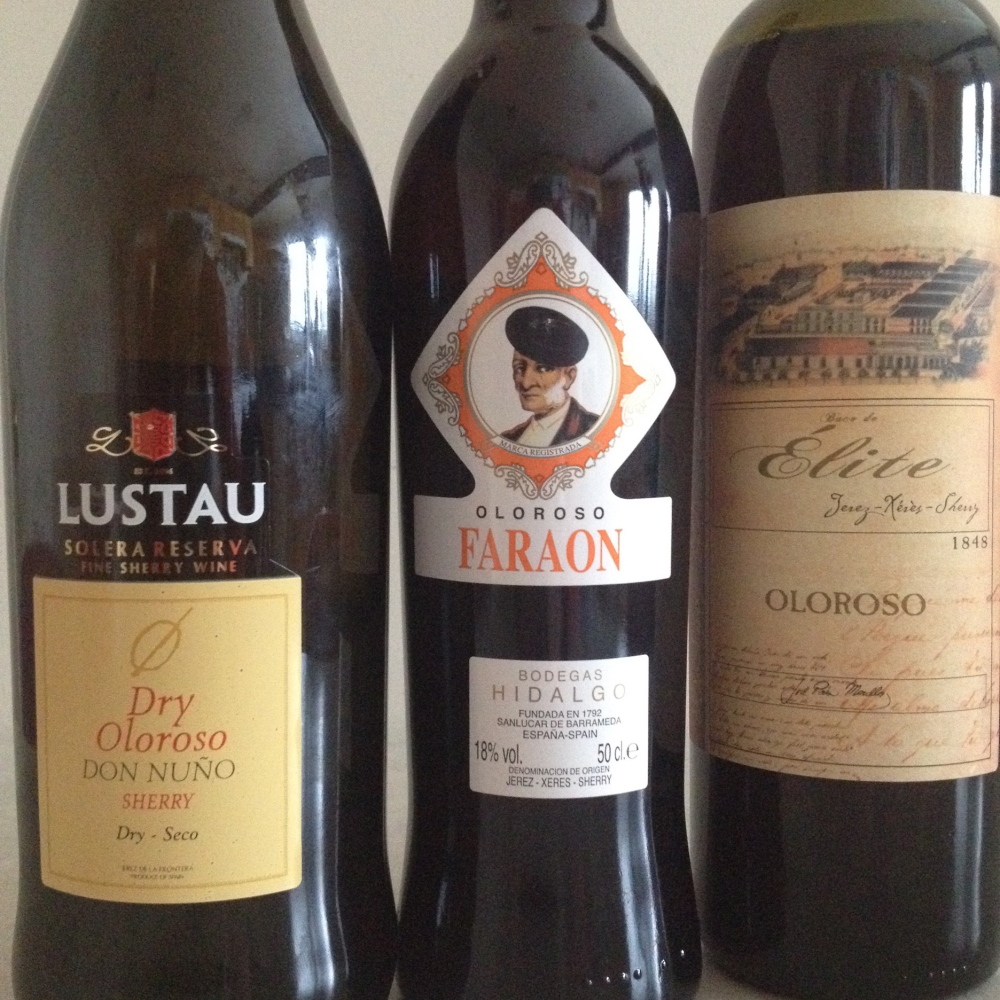In Poe’s classic story “The Purloined Letter,” an amateur detective searching for a stolen letter with incriminating information finds it in the possession of the known thief who managed to conceal it from intensive searching by the police. Although the authorities examined what they thought was every possible hiding spot, the letter eluded them by lying in plain sight, among a bunch of cards.
Poe’s story has been intensively analyzed by academics to a point of absurdity. For me, it is an apt analogy to begin discussing sherry.
Sherry is crucial; it holds a key. We are all looking for what it alone contains, yet we don’t know where to look. We keep searching in the same spots for wines that are dry, that enliven and ennoble a variety of foods from simple to fancy, that possess genuinely unique flavors, that spring from a particular place with a long and interesting history, that tell us something new.
Sometimes we find them; often we find something with which we’re already all too familiar. Our predispositions prevent us from using new eyes to find what we seek.
Another Poe/sherry analogy is personal. My father told and retold to me the story of “The Purloined Letter” many times before I actually read it myself. Until college, I knew it only as a sort of legend, a life lesson, a key to some truth, rather than as an actual experience.
So it has been with sherry: a wine that enjoys the adulation of devout and learned masters, which most of us accept theoretically but in practice ignore. I heard about sherry’s importance for a long time before I learned it for myself.
First of all, let’s just get this out of the way: Little of today’s discussion concerns the cloying cream sherries with which we’re all familiar – Harveys and the like. These, which in most contemporary articles on sherry occupy a category referred to disparagingly as “your grandmother’s,” are just dandy on the rocks or with ice cream. But they are simple, and need little explanation or help in the market. Today’s discussion is of fine wines from the Marco de Jerez, specifically its dry olorosos.
DRY OR SWEET
Sherry comes dry or sweet. The latter are from dried Pedro Ximénez and moscatel grapes, or other wines sweetened by them. The dry wines are from the palomino grape, and fall into different categories determined by weight on the palate as well as the manner in which they age. These range from the lightest, fino and manzanilla, through amontillado and palo cortado to the fullest bodied oloroso. (Of course, an even better known story of Poe’s is “The Cask of Amontillado,” so look forward to what perhaps will become a series of mine on the links between sherry and the 19th-century author.)
Part of what makes sherry sherry is the solera system, a long-term method of “fractional blending” of multiple vintages through different barrels and locations within a given winery, or bodega, over time. Because there’s a lot of new information to absorb when learning about sherry, I will save a deeper exploration of the solera system for a future column.
GROWING OLD
The solera is unique, but the distinction that most noticeably sets sherry apart is the aging process. Sherry ages in barrels that are kept roughly five-sixths of the way full, which invites oxygen and ambient organisms to be full partners. The aging takes place either “biologically” or “oxidatively.”
Biological aging involves flor, a unique veil of Saccharomyces yeasts that reproduce to form a thick layer over the wine as it ages. Flor is a living organism, and imparts distinctive characteristics to the wines with which, over many years of aging, it cohabits.
Sherries that age with flor become fino or manzanilla (the latter when the grapes are from the town of Sanlúcar). Sherries that age without flor, which in part protects a wine from oxygen, age oxidatively into oloroso. Amontillado and palo cortado are often called “intermediate” sherries, since they benefit from both types of aging.
While outside the realm of sherry, wines that are “lighter” in body are often considered less serious than those that are “heavier” or fuller, the consensus is that the greatest sherries are finos and manzanillas – in part due to the unique effects of biological aging.
In theory, then, an exploration of sherry would begin with these lighter, transcendent wines. But for me personally, it took longer to “get” fino than it did oloroso. Fino and manzanilla are so dry, saline and bracing that almost everyone’s first reaction is quizzical, if not negative. If you think you like “dry white wines,” try a fino and receive an instant education in what truly dry wine is like.
Even the driest of non-sherry whites – Muscadet, Santorini assyrtiko, brut nature Champagne, etc. – have at least a sense of sweetness, compared to fino. Truly dry wine bearing the effects of flor introduces itself as a challenge, just about requires food to feel complete, and only in time bares its glorious treasures to the drinker who has done some of that new-eyes predisposition-scrubbing work.
WARMER WELCOME
Oloroso, on the other hand, offers a warmer welcome. While biological aging removes the glycerol from a wine, rendering finos and manzanillas refreshing and light but exceptionally stripped-down, oxidatively aged oloroso manages to retain some glycerol. This yields in the wine a certain weight and pleasing roundness. That body and structural depth are part of what make dry olorosos extraordinary at a dinner table in cold months. (We will discuss fino and manzanilla when the thermometer is reliably above 50 degrees.)
“Oloroso” means perfumed. There are prominent aromas of toasted walnuts, coffee and camp fires, fragrances of the earth. The wines’ savoriness seems never to end: flavors of fresh tobacco, burnished wood, leather, dark chocolate, baking spices, Asian spices. These match well with vigorous dishes: dark meat, roasts and stews of all sorts. Squid, beef stew, barbecue, duck, oily fish, Chinese food (especially with fermented black bean sauce) and chorizo have all been spectacular matches for me. And keep in mind as we go into spring: one of the most difficult foods of all to pair with wine, asparagus, harmoniously matches with oxidative wines, including oloroso.
The reason an uneaten sliced apple turns brown is the same reason oxidative wines do. Oloroso is usually a deep amber color, and for most of us this hue suggests sweetness. I love the cognitive dissonance between oloroso’s suggestions – dark color; caramelized, almost bourbon-like aromas – and its reality. The truth is that I often can’t quite tell whether dry olorosos contain sweetness.
The wines where I can’t quite tell what’s going on are my favorite wines of all. These are the wines where harmony and complexity, rather than particular flavor profiles, are the goal. These are the wines that, having mastered various gustatory challenges, having ably performed many culinary functions, rise to address emotional issues as well. Oloroso is about well-being. And it’s about holding the truth, the key, the stolen letter, in plain sight, patiently waiting for us to stop searching so hard so we might find it.
THREE TO TRY
Lustau Don Nuño Dry Oloroso ($25) is an ideal starting place. It’s on the lithe end, body-wise, with characteristic woodsy notes. It’s almost delicate, in relative terms, and therefore especially well-suited to a wide variety of meals. Begin with cured meats, move on to a bisque, then a roast duck.
Bodegas Hidalgo Oloroso “Faraon” ($19, 500ml) is intensely savory and toothsome. The house is in Sanlúcar, and is therefore justly best known for its manzanilla. The oloroso has some of that wine’s tanginess and grace, though the style is somewhat more rustic and happy-go-lucky. It makes you want to eat anything good and home-cooked.
Dios Baco produces a more modern, sleek style. The Baco de Elite Oloroso ($27) ages for a relatively long time, and shows it in the wood influence as well as pronounced nut aromas and smoky tones. I think of it as a wine for company, drunk with semi-soft cheeses, pâté and a caramelized onion tart.
Joe Appel is the wine writer for the Portland Press Herald/Maine Sunday Telegram. He works at Rosemont Market. He can be reached at:
soulofwine.appel@gmail.com
Send questions/comments to the editors.




Success. Please wait for the page to reload. If the page does not reload within 5 seconds, please refresh the page.
Enter your email and password to access comments.
Hi, to comment on stories you must . This profile is in addition to your subscription and website login.
Already have a commenting profile? .
Invalid username/password.
Please check your email to confirm and complete your registration.
Only subscribers are eligible to post comments. Please subscribe or login first for digital access. Here’s why.
Use the form below to reset your password. When you've submitted your account email, we will send an email with a reset code.